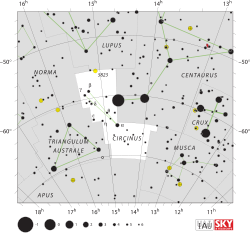Cirkelpassaren
| Cirkelpassaren | |
 | |
| Lista över stjärnor i Cirkelpassaren | |
| Latinskt namn | Circinus |
|---|---|
| Förkortning | Cir |
| Rektascension | 15 h |
| Deklination | -60° |
| Area | 93 grad² (85) |
| Huvudstjärnor | 3 |
| Bayer/Flamsteedstjärnor | 9 |
| Stjärnor med exoplaneter | 2 |
| Stjärnor med skenbar magnitud < 3 | 0 |
| Stjärnor närmare än 50 ljusår | 0 |
| Ljusaste stjärnan | Alfa Circini (3,19m) |
| Närmaste stjärnan | Alfa Circini (53,50 lå) |
| Messierobjekt | 0 |
| Meteorregn | Alfa Circiniderna |
| Närliggande stjärnbilder | Vargen Kentauren Flugan Paradisfågeln Södra triangeln Vinkelhaken, |
| Synlig vid latituder mellan +30° och −90° Bäst synlig klockan 21:00 under juli. | |
Cirkelpassaren (Circinus på latin) är en liten, svag stjärnbild på södra stjärnhimlen.[1][2][3] Konstellationen är en av de 88 moderna stjärnbilderna som erkänns av den Internationella astronomiska unionen.[4]
Historik
Stjärnbilden beskrevs först av den franske astronomen Nicolas Louis de Lacaille 1756, för att täcka en lucka på stjärnhimlen mellan Södra triangeln och Kentaurens framben.
Stjärnor


Cirkelpassaren är en ljussvag stjärnbild med bara några huvudstjärnor som fått Bayer-beteckning.[5][3]
- α - Alfa Circini är den ljusstarkaste stjärnan i Cirkelpassaren, en dubbelstjärna med magnitud 3,19.
- β - Beta Circini är en vit stjärna av magnitud 4,07.
- γ - Gamma Circini är en dubbelstjärna där huvudstjärnan är en blåvit stjärna av magnitud 4,51 och följeslagaren är en gulvit stjärna av magnitud 5,71.
- ε - Epsilon Circini är en orange jätte av magnitud 4,85.
- δ - Delta Circini är en dubbelstjärna av magnitud 5,09.
- Circinus X-1 är en röntgenbinär bestående av en neutronstjärna och en stjärna i huvudserien. Den upptäcktes 14 juni 1969.
Djuprymdsobjekt

Det finns inga Messierobjekt i Cirkelpassaren.[5][3]
Stjärnhopar
- NGC 5823 (Caldwell 88) är en öppen stjärnhop av magnitud 7,9.
- Circinusdvärgen (ESO 97-G13) är en galax som ligger 20 miljoner ljusår bort. Den troddes först vara en dvärggalax, därav namnet. Det har emellertid visat sig att stora delar av galaxen döljs bakom gas- och stoftmoln. Magnitud 9,84.
Nebulosor
- NGC 5315 är en planetarisk nebulosa av magnitud 9,8.
Referenser
- ^ Ian Ridpath och Wil Tirion (2007). Stars and Planets Guide. Princeton University Press, Princeton. ISBN 978-0-00-725120-9
- ^ ”De nutida stjärnbilderna”. Naturhistoriska Riksmuseet. http://www.nrm.se/faktaomnaturenochrymden/rymden/denutidastjarnbilderna.2277.html. Läst 26 januari 2014.
- ^ [a b c] ”Circinus Constellation”. http://www.constellation-guide.com/constellation-list/circinus-constellation/. Läst 26 januari 2014.
- ^ http://www.iau.org/ The International Astronomical Union (IAU)
- ^ [a b] Astronomica – Galaxer – planeter – stjärnor – stjärnbilder – rymdforskning. Tandem Verlag GmbH (svensk utgåva). 2007. sid. 350-351. ISBN 978-3-8331-4371-7
Externa länkar
 Wikimedia Commons har media som rör Cirkelpassaren.
Wikimedia Commons har media som rör Cirkelpassaren.
| ||||||||||||||||
Media som används på denna webbplats
Författare/Upphovsman: Till Credner, Licens: CC BY-SA 3.0
Photo of the constellation Circinus, the Dividers
This is Chandra's X-ray image of the neutron star in Circinus X-1. Low energy X-rays are shown in red, medium energy X-rays in green and high energies in blue. The jet itself is seen to the upper right corner and consists of two fingers of X-ray emission (shown in red) separated by about 30 degrees. These two fingers, located at least about 5 light years from the neutron star, may represent the outer walls of a wide jet. Alternatively, they may represent two separate, highly collimated jets produced at different times by a precessing neutron star. That is, the neutron star may wobble like a top as it spins and the jet fires at different angles at different times. The structures on the opposite side (red, to the lower left) may be evidence for counter jets. The rest of the colored areas surrounding the bright central source are instrumental artifacts and not representative of structures associated with Circinus X-1. The jet in Circinus X-1 is helping astronomers better understand how neutron stars, and not just black holes, can generate these powerful beams. Many jets have been found originating near black holes (both the supermassive and stellar-mass variety), but the Circinus X-1 jet is the first extended X-ray jet associated with a neutron star in a binary system. This detection shows that the unusual properties of black holes -- such as presence of an event horizon and the lack of an actual surface -- may not be required to form powerful jets. The result also reveals how efficient neutron stars can be as cosmic power factories.
Författare/Upphovsman: IAU and Sky & Telescope magazine (Roger Sinnott & Rick Fienberg), Licens: CC BY 3.0
IAU Circinus chart
NGC 5315





